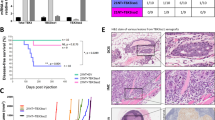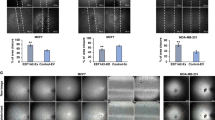Abstract
The comparative biological properties of NBT-II cells, a rat bladder carcinoma cell line constitutively expressing FGF-1 and FGF-2 were analysed in nude mice. FGF-1 is not secreted by the transfected cells unless the cDNA contains a signal sequence; conversely, NBT-II cells transfected with FGF-2 coding sequence produce and secrete the factor in a biologically active form. Bovine brain capillary endothelial cells are stimulated to proliferate upon addition of medium conditioned by the FGF-2-producing cells and this activity can be abrogated by the addition of anti-FGF-2 blocking antibodies. In addition, the FGF-2-containing medium, which cannot stimulate NBT-II cells due to absence of appropriate receptors, is able to induce scattering of NBT-II cells expressing the FGFR1. It has been reported previously that FGF-1-producing cells are highly tumorigenic in nude mice and induce carcinoma with a period of latency reduced from 6 to 5 weeks when compared to parental NBT-II cells. In contrast, NBT-II cells producing FGF-2 are no more tumorigenic than parental cells, indicating that FGF-1 and FGF-2 have different oncogenic properties in carcinoma. FGF-1 and FGF-2 are potent antiogenic factors that trigger the host endothelial cells. VEGF, another potent angiogen was found to be expressed in small amounts by NBT-II cells and to be expressed in reduced amount in the FGF-producing cells. In the NBT-II system in vivo FGF-1 and FGF-2 are highly and comparatively angiogenic in the resultant carcinoma and this occurs in the absence of production of significant amounts of VEGF by the carcinoma cells. Taken together, our results indicate that activated angiogenesis is not sufficient for rapid tumor expansion. FGF-1 behaves as a tumorigenic factor in the NBT-II bladder carcinoma cell model, whereas expression and secretion of large amounts of FGF-2 are not sufficient for increasing tumor growth.
This is a preview of subscription content, access via your institution
Access options
Subscribe to this journal
Receive 50 print issues and online access
$259.00 per year
only $5.18 per issue
Buy this article
- Purchase on Springer Link
- Instant access to full article PDF
Prices may be subject to local taxes which are calculated during checkout
Similar content being viewed by others
Author information
Authors and Affiliations
Rights and permissions
About this article
Cite this article
Jouanneau, J., Plouet, J., Moens, G. et al. FGF-2 and FGF-1 expressed in rat bladder carcinoma cells have similar angiogenic potential but different tumorigenic properties in vivo. Oncogene 14, 671–676 (1997). https://doi.org/10.1038/sj.onc.1200883
Received:
Revised:
Accepted:
Issue Date:
DOI: https://doi.org/10.1038/sj.onc.1200883
Keywords
This article is cited by
-
Direct FGF receptor 1 activation through an anti-idiotypic strategy mimicks the biological activity of FGF-2 and inhibits the progression of the bladder carcinoma derived from NBT-II cells
Oncogene (2004)
-
Rapid tumor development and potent vascularization are independent events in carcinoma producing FGF-1 or FGF-2
Oncogene (2002)
-
Loss of heterozygosity at 4p16.3 and mutation of FGFR3 in transitional cell carcinoma
Oncogene (2001)
-
Regulation of proliferation-survival decisions is controlled by FGF1 secretion in retinal pigmented epithelial cells
Oncogene (2000)
-
The community effect in FGF-1 mediated tumor progression of a rat bladder carcinoma does not involve a direct paracrine signaling
Oncogene (1999)



